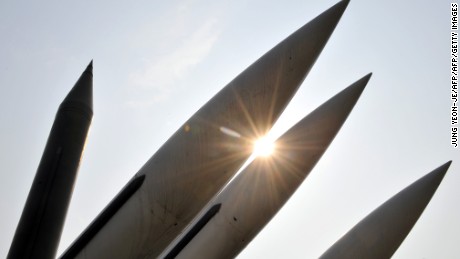Headline News
Banning Short-Range Nuclear-Capable Missiles from South Asia

India and Pakistan possess short-range ballistic missiles which are capable of carrying both conventional and nuclear warheads. Pakistan’s short range cruise missiles are also capable of carrying nuclear warheads. In addition, Pakistan has also developed a 60km range tactical nuclear weapon (TNW) called the Nasr. Such developments pose a threat to regional stability in the South Asian periphery. As these missiles jeopardize strategic stability and enhance vulnerability, a viable solution would be to ban such missile systems from South Asia.
In this article, we discuss the legal frameworks that could make such a move acceptable to both states.
Doctrines of Arms Control
India’s Draft Nuclear Doctrine upholds the government’s belief in nuclear arms control measures as “part of its national security policy to reduce potential threats.”1
It is difficult to analyze Islamabad’s views on nuclear arms control measures, since Pakistan does not have a comparable, written nuclear doctrine. However, Islamabad is already a party to both the Biological Weapons Convention and the Chemical Weapons Convention—the other two weapons of mass destruction under international law.2
As Pakistan strives to achieve a “credible minimum nuclear deterrent,” strengthening regional stability rather than jeopardizing it would always remain the viable solution. Small but vital steps taken toward nuclear arms reduction could pave the path for nuclear arms control and, it is hoped, full nuclear disarmament in the longer term.
Pakistan’s and India’s nuclear-capable short-range capability
For Pakistan, short-range ballistic missiles include: Hatf-1, with ranges between 70-100km; Abdali, with a range of 180km; Ghaznavi, with a range of 290km; Nasr, with a range of 60km; Shaheen I, with a range of 900km; and cruise missiles such as the air-launched Ra’ad, with a range 350km and the sea-, air-, and ground-capable Babur, with a range of 700km. All these ballistic missiles are reported to be road-mobile and solid-propelled.3
India’s ballistic missile arsenal includes: Prithvi I, with a range of 150km; Prithvi II, with a range of 250km; Prithvi III, with a range of 350km; and Agni I, with a range of 700km. In order to enhance counter strike capability, New Delhi is also developing submarine launched missiles like Shaurya and Sagarika. The Agni I missiles are reported to be road or rail-mobile and are solid propelled, while Prithvi I and II are liquid propelled. Submarine-launched solid propelled missiles like the Sagarika and Shaurya strengthen India’s counter-strike capability, thereby validating its “no first-use” doctrine.
Some of these short-range nuclear-capable missiles are seen as destabilizing, and if used in times of crisis, could lead to a larger-scale nuclear catastrophe. Even though nuclear weapons are under stringent command and control in both states, control could pass to battlefield commanders during a crisis, with the attendant risk of irrational decisions.
As Monika Chansoria notes, “While both nations understandably have compelling concerns for their respective defence and deterrence policies, the dangers of nuclear escalation and consequent catastrophe are equally established.”4
Therefore, a viable way to avert a nuclear catastrophe, at least at a localized level, is to ban nuclear-capable short-range missiles in order to prevent an escalating nuclear conflict. Such a ban was also endorsed by Indian and Pakistani participants at a Track II workshop organized by the Stimson Centre in 2003.5
Vijay Shankar, a former Commander-in-Chief of the Strategic Forces Command in India, has also suggested the “rejection of short-range nuclear missiles” and therefore the “descent of tactical nuclear weapons as an effective Nuclear Risk Reduction Measure.”6
What should be done?
Analyst Monika Chansoria has proposed a ban on obsolete nuclear-capable ballistic missiles from the South Asian periphery as an effective confidence building measure. These include the Prithvi I and II for India and the Hatf I and Hatf II for Pakistan. She notes that “these systems have outlived their strategic utility for operational and technical reasons and are inherently dangerous and destabilizing due to forward deployment.” She further highlights the safety concerns regarding these obsolete missile systems.7
While Chansoria has specifically suggested banning obsolete weapons systems, this move should be extended to include those short-range missiles in each country’s arsenals that are nuclear-capable and not presently outdated.
Thus, the following steps could be taken to successfully eliminate short-range nuclear-capable missiles from the South Asian region.
- Define short-range nuclear-capable missiles.* The definition of short-range nuclear-capable missiles could be “any ballistic or cruise missile, ground, sea and air launched within the range of 500km.” Hence, any ballistic or cruise missile above the range of 500km should not be subject to the proposal. For both India and Pakistan, any missile with a range exceeding 500km could serve a strategic purpose. This means missiles like the Agni I, Shaheen I, Shaurya and Sagarika, as well as the Babur submarine launched cruise missile and Babur ground-launched cruise missiles, could be left out of the proposal.
At the same time, any nuclear-capable ballistic or cruise missile with range below 500km, irrespective of its launch mode, that is whether ground launched, air launched or sea launched, should fall under the purview of the proposal. - Convert the proposal into a treaty.* With the implementation of a “Treaty to Ban Very Short-Range Nuclear Missiles from South Asia” both India and Pakistan would be bound to abide by the norms of eliminating their short range (below 500km range) nuclear missile capabilities. As Dr. Manpreet Sethi, puts it, “devaluing nuclear weapons would be an effective way to ultimately discard them.”8 In this context, devaluation of nuclear-capable short-range missiles could result in escalation control and in the long run enable both Pakistan and India to take bigger steps towards nuclear arms control measures.
- Emulate the INF Treaty to eliminate modern short-range missile systems.* The Intermediate-range Nuclear Forces [INF]Treaty provides a classic example of how two superpowers agreed to eliminate an entire class of nuclear weapons system (that is, the intermediate-range ground-launched nuclear missiles, both ballistic and cruise). Those eliminated missiles included some of the most sophisticated systems then under development, such as the Soviet SS-20s and the US Pershings. Hence, if the INF treaty is taken as a model to eliminate both obsolete and cutting-edge missile technology, the chances of destabilization would be further reduced.
- Effective verification body.* A special verification body needs to be set up to verify from time to time whether both states are developing such capabilities. Stringent verification measures need to be taken on missile production sites so that these weapons are neither deployed nor produced, further ensuring a satisfactory level of transparency. Under this treaty, one of the important requirements should be that neither India nor Pakistan should be allowed to test fire missiles of ranges less than 500km.
- Allow the modification of these missiles for conventional roles.* Both India and Pakistan could modify nuclear-capable missiles, enabling them to carry out conventional roles. This of course would be unlike the INF treaty, which demands complete elimination of intermediate-range vehicles and does not allow these missiles to be converted for conventional use. However, for both India and Pakistan, conventionally armed short-range missiles could provide a boost to their artillery, thereby, providing an advantage to their conventional capabilities, further reducing reliance on nuclear weapons.
Factors that can hinder the process of banning nuclear-capable missiles
While a mutual ban on short-range ballistic missiles appears to be a feasible and logical decision for both New Delhi and Islamabad, there are various factors which could hinder this process.
- Lack of mutual trust. Since the process includes elimination of nuclear-capable missiles, it would require the two states to be able to trust each other on matters of verification. This could be a difficult task since both India and Pakistan’s missiles are de-mated from their nuclear warheads. Hence, verification would depend on the goodwill of the two states to provide the accurate information on the elimination process.
- Disagreement on TNWs. Pakistan, which considers the Nasr to be successful in curbing any conventional attack from India, needs to be persuaded that tactical use of this missile could have a spill-over effect in its own territory. This is because these missiles would need to be deployed close to the borders during times of crisis, which could make them vulnerable to Indian artillery and air force attack. Since these missiles would be nuclear-armed, the nuclear catastrophe would hence be disastrous for Pakistan’s forces.
Moreover, just like India, Pakistan too does not need TNWs to counter their adversary or adversaries. Pakistan’s strategic missile capabilities, the Shaheens and Babur would be better suited as a deterrent.
At the battlefield level, Pakistan’s weapons could be irrationally used if control were to pass to the battlefield commander—that is to say, command and control could be decentralized. This could in return initiate a massive retaliation from the Indian side, as already stated in its nuclear doctrine. This would mean that India might launch its counter-strike on Islamabad’s counter-value targets, which could be too costly a bet for a weapon of minimal utility.
The China factor
While many analysts may raise the issue of the China factor, that is to include China in the nuclear arms control process, the threat from Chinese short-range nuclear-capable missiles is not relevant to Pakistan, which has had consistently close relationship with its northern neighbour.
At the same time, the China factor is unlikely to trouble India. One reason is that the nuclear threshold for India and China is comparatively high (as compared to the India-Pakistan nuclear threshold) since both China and India adopted a “no-first use” doctrine.
Moreover, any putative nuclear attack from China would likely be answered with the longer range Agni IV and V (and the not yet deployed Agni VI) missiles, not with missiles below the range of 500km. Therefore, India does not really lose even if China is not included in this agreement.
Finally, even if China were to acknowledge India’s nuclear status in the near future, it does not admit to possession of TNWs in its own arsenal.9 An India-Pakistan SRBM agreement—essentially a tactical weapons treaty—may thus not attract Chinese attention because of Beijing’s blind spot regarding that class of weapon.10
The Future
In future, both New Delhi and Islamabad must strive towards a more stable nuclear balance in South Asia. Short-range nuclear-capable missiles of range below 500km are destabilizing and such missiles need to be eliminated .
Such a small step towards nuclear risk reduction could in future lead both states to take further steps towards nuclear reduction measures.
Debalina Ghoshal is a research associate at the Delhi Policy Group, New Delhi.
Notes
1 “India’s Draft Nuclear Doctrine,” Arms Control Association. www.armscontrol.org/act/1999_07-08/ffja99
2 “Arms Control and Proliferation Profile: Pakistan,” Arms Control Association, updated July 2013. www.armscontrol.org/factsheets/pakistanprofile
3 James C O’ Halloran, “Pakistan,” IHS Jane’s Weapons: Strategic (IHS Global Ltd, 2013-2014).
4 Monika Chansoria, “Want True CBM? Banish short-range Missiles in South Asia,” The Sunday Guardian. www.sunday-guardian.com/analysis/want-true-cbm-banish-short-range-missiles-in-south-asia
5 Michael Krepon, “Nuclear Risk Reduction Redux in South Asia,” Stimson Centre, July 6, 2010. www.stimson.org/essays/nuclear-risk-reduction-redux-in-south-asia
6 Vijay Shankar, “India-Pakistan: Nuclear Risk Reduction Measures,” Institute of Peace and Conflict Studies, February 10, 2014. ipcs.org/article/india/nuke-street-nuclear-security-summit-2014-and-the-nti-index-4301.html
7 Monika Chansoria, “India-Pak nuclear CBM liked by people,” The Sunday Guardian. www.sunday-guardian.com/analysis/india-pak-nuclear-cbm-liked-by-people
8 Manpreet Sethi, “Reducing Reliance on Nuclear Weapons,” in ed., Manpreet Sethi, Towards a Nuclear Weapons Free World (New Delhi: Knowledge World Publications, 2009), p.98
9 Charles D Fergusson, Evan S. Medeiros, Phillip C. Saunders, “Chinese Tactical Nuclear Weapons,” in ed. Brian Alexander and Alistair Millar, Tactical Nuclear Weapons: Emergent Threats in an Evolving Security Environment (Dulles, VA: Potomac Books, 2003).
10 “China’s Nuclear Stockpile and Deployments.” cns.miis.edu/archive/country_china/coxrep/wdepdat.htm
Headline News
How Canadian churches are helping their communities cope with the wildfires

As wildfires burn across Canada, churches are finding ways to support their members and the broader community directly impacted by the crisis.
According to the Canadian Interagency Forest Fire Centre, as of June 13, there are 462 active fires across Canada – and 236 of them classified as out of control fires.
Whether it’s through phone calls or donations to community members, here’s how a few churches across Canada are handling active wildfires and the aftermath in their regions.
Westwood Hills, N.S.: St. Nicholas Anglican Church
In Nova Scotia, St. Nicholas Anglican Church and other churches in the area are collecting money for grocery cards to give to families impacted by the Tantallon wildfire.
Right outside of Halifax, N.S., the Tantallon wildfire destroyed 151 homes. More than 16,000 people evacuated the area due to the fire.
The fire is now considered contained, but Tanya Moxley, the treasurer at St. Nicholas is organizing efforts to get grocery gift cards into the hands of impacted families.
As of June 12, four churches in the area – St. Nicholas, Parish of French Village, St Margaret of Scotland and St John the Evangelist – raised nearly $3,500. The money will be split for families’ groceries between five schools in the area impacted by the wildfire.
Moxley said she felt driven to raise this money after she heard the principal of her child’s school was using his own money to buy groceries for impacted families in their area.
“[For] most of those people who were evacuated, the power was off in their subdivision for three, four or five days,” she said. “Even though they went home and their house was still standing, the power was off and they lost all their groceries.”
Moxley said many people in the area are still “reeling” from the fires. She said the church has an important role to help community members during this time.
“We’re called to feed the hungry and clothe the naked and house the homeless and all that stuff, right? So this is it. This is like where the rubber hits the road.”

Headline News
Is it ever OK to steal from a grocery store?

Mythologized in the legend of Robin Hood and lyricized in Les Misérables, it’s a debate as old as time: is it ever permissible to steal food? And if so, under what conditions? Now, amid Canada’s affordability crisis, the dilemma has extended beyond theatrical debate and into grocery stores.
Although the idea that theft is wrong is both a legally enshrined and socially accepted norm, the price of groceries can also feel criminally high to some — industry data shows that grocery stores can lose between $2,000 and $5,000 a week on average from theft. According to Statistics Canada, most grocery item price increases surged by double digits between 2021 and 2022. To no one’s surprise, grocery store theft is reportedly on the rise as a result. And if recent coverage of the issue rings true, some Canadians don’t feel bad about shoplifting. But should they?
Kieran Oberman, an associate professor of philosophy at the London School of Economics and Political Science in the United Kingdom, coined the term “re-distributive theft” in his 2012 paper “Is Theft Wrong?” In simplest terms, redistributive theft is based on the idea that people with too little could ethically take from those who have too much.
“Everybody, when they think about it, accepts that theft is sometimes permissible if you make the case extreme enough,” Oberman tells me over Zoom. “The question is, when exactly is it permissible?”
Almost no one, Oberman argues, believes the current distribution of wealth across the world is just. We have an inkling that theft is bad, but that inequality is too. As more and more Canadians feel the pinch of inflation, grocery store heirs accumulate riches — Loblaw chair and president Galen Weston, for instance, received a 55 percent boost in compensation in 2022, taking in around $8.4 million for the year. Should someone struggling with rising prices feel guilty when they, say, “forget” to scan a bundle of zucchini?

Headline News
The homeless refugee crisis in Toronto illustrates Canada’s broken promises

UPDATE 07/18/2023: A coalition of groups arranged a bus to relocate refugees to temporarily stay at a North York church on Monday evening, according to CBC, CP24 and Toronto Star reports.
Canadians live in a time of threadbare morality. Nowhere is this more obvious than in Toronto’s entertainment district, where partygoers delight in spending disposable income while skirting refugees sleeping on sidewalks. The growing pile of luggage at the downtown corner of Peter and Richmond streets resembles the lost baggage section at Pearson airport but is the broken-hearted terminus at the centre of a cruel city.
At the crux of a refugee funding war between the municipal and federal governments are those who have fled persecution for the promise of Canada’s protection. Until June 1, asylum seekers used to arrive at the airport and be sent to Toronto’s Streets to Homes Referral Assessment Centre at 129 Peter St. in search of shelter beds. Now, Toronto’s overcrowded shelter system is closed to these newcomers, so they sleep on the street.
New mayor Olivia Chow pushed the federal government Wednesday for at least $160 million to cope with the surge of refugees in the shelter system. She rightly highlights that refugees are a federal responsibility. In response, the department of Immigration, Refugees, and Citizenship Canada points to hundreds of millions in dollars already allocated to cities across Canada through the Interim Housing Assistance Program, while Ontario says it has given nearly $100 million to organizations that support refugees. But these efforts are simply not enough to deliver on Canada’s benevolent promise to the world’s most vulnerable.
The lack of federal generosity and finger-pointing by the city has orchestrated a moral crisis. It’s reminiscent of the crisis south of the border, where Texas governor Greg Abbott keeps bussing migrants to cities located in northern Democratic states. Without the necessary resources, information, and sometimes the language skills needed to navigate the bureaucratic mazes, those who fled turbulent homelands for Canada have become political pawns.
But Torontonians haven’t always been this callous.
In Ireland Park, at Lake Ontario’s edge, five statues of gaunt and grateful refugees gaze at their new home: Toronto circa 1847. These statues honour a time when Toronto, with a population of only 20,000 people, welcomed 38,500 famine-stricken migrants from Ireland. It paralleled the “Come From Away” event of 9/11 in Gander, N.L., where the population doubled overnight, and the people discovered there was indeed more than enough for all. It was a time when the city lived up to its moniker as “Toronto, The Good.”
Now, as a wealthy city of three million people, the city’s residents are tasked with supporting far fewer newcomers. Can we not recognize the absurdity in claiming scarcity?




